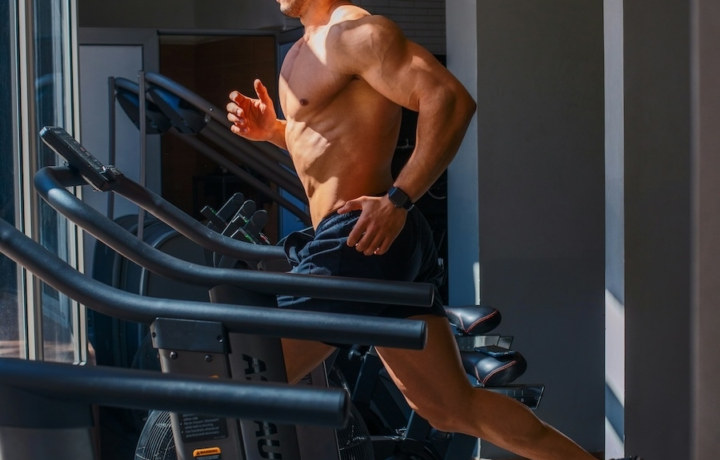Exercise
Side Shuttle

Side Shuttle
How to Perform
- Start by standing with your feet shoulder-width apart, knees slightly bent, and core engaged to establish a strong athletic position.
- Shift your weight onto one leg and push off explosively to the side, maintaining a low center of gravity throughout the movement.
- Land softly on the opposite foot while absorbing the impact through your ankle, knee, and hip joints, exhaling as you land.
- Immediately push off in the opposite direction without pausing, keeping your torso upright and shoulders level.
- Continue moving laterally for the prescribed distance or number of repetitions, breathing rhythmically with each direction change.
- Maintain athletic readiness by keeping your arms slightly bent at the elbows and moving them naturally in opposition to your lower body.
- Keep your toes pointed forward throughout the exercise to protect your knees and ankles from rotational stress.
- Focus on quick, powerful movements while maintaining control of your body position and alignment at all times.
Important information
- Keep your chest up and shoulders back throughout the entire movement to prevent hunching or leaning too far forward.
- Make sure you're pushing off the ground with your entire foot, not just your toes, to maximize power and stability.
- Avoid letting your knees collapse inward when landing—maintain alignment between your knee and second toe.
- Start with shorter distances until you master the technique, then gradually increase the distance and speed as your coordination improves.

Side Shuttle
Exercise Details
Primary Muscles
Muscle Groups
Mechanic
Built for progress
Take the guesswork out of training
Create personalized AI-powered workout plans that evolve with you. Train smarter, track every rep and keep moving forward, one workout at a time.






The Side Shuttle elevates your cardio routine by introducing lateral movement patterns that many traditional exercises miss. This intermediate-level drill challenges your body in a different plane of motion, engaging the glutes, quads, and abductors simultaneously while delivering an impressive cardiovascular punch.
Popular in both HIIT and CrossFit training circles, Side Shuttles create a perfect storm of muscular engagement and heart rate elevation. The lateral movement pattern specifically targets the often-neglected abductor muscles along the outer thigh, helping build stability and reducing the risk of knee issues common in athletes who only train in forward-backward movements.
Your glutes fire powerfully with each direction change, serving as both stabilizers and prime movers throughout the exercise. Meanwhile, your quads work overtime managing the rapid deceleration and acceleration phases, building functional strength that translates to improved performance in various sports and daily activities.
What makes Side Shuttles particularly valuable is their efficiency. In just a few minutes, you'll challenge your endurance capacity while boosting cardiovascular fitness through the repeated explosive movements. The exercise creates substantial metabolic demand, making it ideal for those looking to improve conditioning or incorporate fat-burning elements into their training regimen.
Beyond the physical benefits, Side Shuttles improve coordination, agility, and spatial awareness – athletic qualities that deteriorate without specific training. The exercise demands mental focus alongside physical effort, creating a brief but intense mind-body challenge that can break the monotony of conventional cardio options.
For athletes specifically, the movement mimics the defensive slides common in basketball, tennis, and numerous other sports, making it functional training in its truest form. Even for non-athletes, the ability to move efficiently sideways builds resilience against falls and improves overall mobility. This exercise truly represents fitness versatility at its finest – challenging, efficient, and remarkably effective.
FAQ - Side Shuttle
Side Shuttles primarily engage the lateral hip muscles (abductors), glutes, and quadriceps while also challenging your cardiovascular system. The outer thigh muscles get particular attention due to the lateral movement pattern, making this exercise excellent for building lower body stability.
Beginners can reduce the distance between cones/markers and move at a controlled pace without jumping. To increase difficulty, advanced athletes can add a resistance band around the thighs, increase shuttle distance, or incorporate explosive lateral jumps between positions.
Include Side Shuttles 2-3 times weekly as part of your HIIT routine, warm-up, or agility training. They work well in circuits of 20-30 seconds per set with adequate rest between sets to maintain proper form and intensity.
The most common errors include not staying in an athletic stance (knees bent, chest up), letting the feet cross over instead of shuffling, and failing to decelerate properly at direction changes. Focus on maintaining a low center of gravity and landing softly to protect your knees.
While Side Shuttles can actually improve knee stability long-term by strengthening supporting muscles, those with existing knee issues should start cautiously with smaller, controlled movements. Avoid this exercise during acute knee pain, and consider consulting a physical therapist for appropriate modifications.







